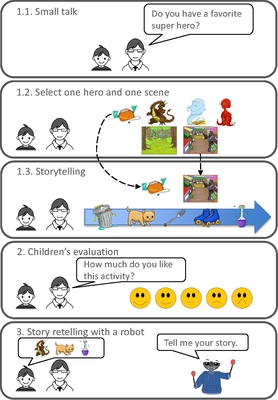Collaborative Storytelling between Robot and Child: A Feasibility Study
In this paper, we envision a robot that collaborates with a child to create oral stories in a highly interactive manner.
June 27, 2017
Interaction Design and Children (IDC) 2017
Authors
Ming Sun (Disney Research)
Iolanda Leite (Disney Research/KTH Royal Institute of Technology)
Jill Fain Lehman (Disney Research)
Boyang Albert Li (Disney Research)
Collaborative Storytelling between Robot and Child: A Feasibility Study
Joint storytelling is a common parent-child activity and brings multiple benefits such as improved language learning for children. Most existing storytelling robots offer rigid interaction with children and do not contribute to children’s stories. In this paper, we envision a robot that collaborates with a child to create oral stories in a highly interactive manner. We performed a Wizard-of-Oz feasibility study, which involved 78 children between 4 and 10 years old, to compare two collaboration strategies: (1) inserting new story content and relating it to the existing story and (2) inserting content without relating it to the existing story. We hypothesize the first strategy can foster true collaboration and create rapport, whereas the second is a safe strategy when the robot cannot understand the story. We observed that, although the first strategy creates heavier cognitive load, it was as enjoyable as the second. We also observed some indications that the first strategy may mitigate the difficulties in story creation for young children under the age of 7 and encourage children to speak more. This study suggests that a mixture strategy is feasible for robots in collaborative storytelling, providing sufficient cognitive challenge while concealing its shortcomings on natural language understanding.

